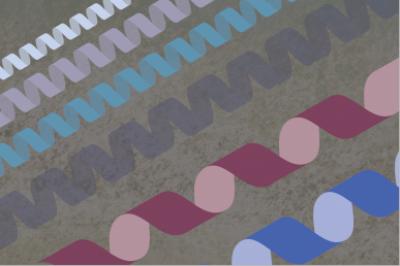Magnetic nanocubes self-assemble into helical superstructures

This image depicts an illustration of helices. Credit: UIC/Megan Strand
Nanoparticles of magnetite, the most abundant magnetic material on earth, are found in living organisms from bacteria to birds. Nanocrystals of magnetite self-assemble into fine compass needles in the organism that help it to navigate.
Collaborating with nanochemists led by Rafal Klajn at the Weizmann Institute of Science in Israel, who found that magnetite nanocubes can self-assemble into helical superstructures under certain conditions, University of Illinois at Chicago theoretical chemist Petr Kral and his students simulated the phenomenon and explained the conditions under which it can occur. The joint study is online in Science Express in advance of print in the Sept. 5 issue of Science.
The Weizmann researchers dissolved the nanocrystals and exposed the solution to an external magnetic field. As the solution evaporated, helical chains of nanoparticles formed. Surprisingly, the spiral helices were chiral — that is, either left- or right-handed — despite the fact that the nanoparticles themselves are not chiral. Densely packed assemblies of helices tended to adopt the same handedness.
Kral's UIC team modeled the self-assembly to determine how helices formed in their collaborators' experiments — and why the helices had chirality.
They found that the self-assembly into chiral helices is the result of the competing forces acting on them — Zeeman force from the external magnetic field, dipole-dipole magnetic force, magneto-anisotropic directional force, weakly attractive van der Waals forces, and others. The chemistry of the nanoparticle ligands, the solvent, and temperature may also play a role.
In the presence of an external magnetic field, the superparamagnetic nanocubes — which are randomly magnetic and can flip with temperature changes — became tiny magnets with different symmetries of the competing forces acting between them. As a result, when two cubes are face-to-face, they tend to tilt with respect to each other, forming a small angle to the right or left — the seed of a chiral helix, as more nanocubes line up with the first two.
Kral's analysis used a Monte Carlo computer algorithm, which relies on repeated random sampling, running simulations many times over.
“We had to write a new, efficient Monte Carlo computer code describing all the necessary terms, all the values, and then explain how the highly unusual behavior that Klajn observed – the helices' self-assembly – happens,” Kral said.
Gurvinder Singh of the Weizmann Institute is first author of the paper. Elijah Gelman of the Weizmann Institute, and Henry Chan, Artem Baskin and Nikita Repnin of UIC are co-authors on the study.
The work was supported by the Israel Science Foundation grant 1463/11, the G. M. J. Schmidt-Minerva Center for Supramolecular Architectures, the Minerva Foundation with funding from the Federal German Ministry for Education and Research, National Science Foundation Division of Materials Research grant 1309765 and the American Chemical Society Petroleum Research Fund grant 53062-ND6.
Media Contact
More Information:
http://www.uic.eduAll latest news from the category: Materials Sciences
Materials management deals with the research, development, manufacturing and processing of raw and industrial materials. Key aspects here are biological and medical issues, which play an increasingly important role in this field.
innovations-report offers in-depth articles related to the development and application of materials and the structure and properties of new materials.
Newest articles

Superradiant atoms could push the boundaries of how precisely time can be measured
Superradiant atoms can help us measure time more precisely than ever. In a new study, researchers from the University of Copenhagen present a new method for measuring the time interval,…

Ion thermoelectric conversion devices for near room temperature
The electrode sheet of the thermoelectric device consists of ionic hydrogel, which is sandwiched between the electrodes to form, and the Prussian blue on the electrode undergoes a redox reaction…

Zap Energy achieves 37-million-degree temperatures in a compact device
New publication reports record electron temperatures for a small-scale, sheared-flow-stabilized Z-pinch fusion device. In the nine decades since humans first produced fusion reactions, only a few fusion technologies have demonstrated…





















